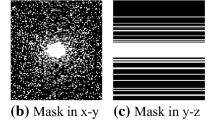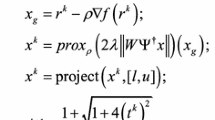Abstract
Magnetic resonance imaging (MRI) has exhibited an outstanding performance in the track of medical imaging compared to several imaging modalities, such as X-ray, positron emission tomography and computed tomography. MRI modality suffers from protracted scanning time, which affects the psychological status of patients. This scanning time also increases the blurring levels in MR image due to local motion actions, such as breathing as in the case of cardiac imaging. An acquisition technique called compressed sensing has contributed to solve the drawbacks of MRI and decreased the acquisition time by reducing the quantity of the measured data that is needed to reconstruct an image without significant degradation in image quality. All recent works have used different types of conventional wavelets for sparsifying the image, which employ constant filter banks that are independent of the characteristics of the input image. This paper proposes to use the empirical wavelet transform (EWT) which tunes its filter banks to the characteristics of the analyzed images. In other words, we use EWT to produce a sparse representation of the MRI images which yields a more accurate sparsification transform. In addition, the grey wolf optimizer is used to optimize the parameters of the proposed method. To validate the proposed method, we use three MRI datasets of different organs: brain, cardiac and shoulder. The experimental results show that the proposed method outperforms the state-of-the-art methods in terms of signal-to-noise ratio and structure similarity metrics.










Similar content being viewed by others
Explore related subjects
Discover the latest articles, news and stories from top researchers in related subjects.Notes
References
Cheng J, Zhao M, Lin M, Chiu B (2017) AWM: Adaptive Weight Matting for medical image segmentation. In: Medical imaging 2017: image processing, vol 10133. International Society for Optics and Photonics, p. 101332P
Lin M et al (2017) Prostate lesion detection and localization based on locality alignment discriminant analysis. In: Medical imaging 2017: computer-aided diagnosis, vol 10134. International Society for Optics and Photonics, p 101344A
Hennig J, Nauerth A, Friedburg H (1986) RARE imaging: a fast imaging method for clinical MR. Magn Reson Med 3(6):823–833
Gibby WA (2000) Faster MRI. In Neuroimaging: clinical and physical principles, no. 494, p 227
Mansfield P (1977) Multi-planar image formation using NMR spin echoes. J Phys C Solid State Phys 10(3):L55
Feinberg DA, Hale JD, Watts JC, Kaufman L, Mark A (1986) Halving MR imaging time by conjugation: demonstration at 3.5 kG. Radiology 161(2):527–531
Pruessmann KP, Weiger M, Börnert P, Boesiger P (2001) Advances in sensitivity encoding with arbitrary k-space trajectories. Magn Reson Med 46(4):638–651
Griswold MA et al (2002) Generalized autocalibrating partially parallel acquisitions (GRAPPA). Magn Reson Med 47(6):1202–1210
Donoho DL (2006) Compressed sensing. IEEE Trans Inf Theory 52(4):1289–1306
Candès EJ, Romberg J, Tao T (2006) Robust uncertainty principles: exact signal reconstruction from highly incomplete frequency information. IEEE Trans Inf Theory 52(2):489–509
Lustig M, Donoho D, Pauly JM (2007) Sparse MRI: the application of compressed sensing for rapid MR imaging. Magn Reson Med 58(6):1182–1195
Ma S, Yin W, Zhang Y, Chakraborty A (2008) An efficient algorithm for compressed MR imaging using total variation and wavelets. In: IEEE conference on computer vision and pattern recognition. CVPR 2008. IEEE, pp 1–8
Yang J, Zhang Y, Yin W (2010) A fast alternating direction method for TVL1-L2 signal reconstruction from partial Fourier data. IEEE J Sel Top Signal Process 4(2):288–297
Huang J, Zhang S, Metaxas D (2011) Efficient MR image reconstruction for compressed MR imaging. Med Image Anal 15(5):670–679
Beck A, Teboulle M (2009) A fast iterative shrinkage-thresholding algorithm for linear inverse problems. SIAM J Imaging Sci 2(1):183–202
Chen C, Huang J (2012) Compressive sensing MRI with wavelet tree sparsity. In: Advances in neural information processing systems, pp 1115–1123
Kingsbury N (2001) Complex wavelets for shift invariant analysis and filtering of signals. Appl Comput Harmon Anal 10(3):234–253
Kingsbury N (1999) Image processing with complex wavelets. Philos Trans R Soc Lond A Math Phys Eng Sci 357(1760):2543–2560
Ragab M, Omer OA, Hussien HS (2017) Compressive sensing MRI using dual tree complex wavelet transform with wavelet tree sparsity. In: 34th National Radio Science Conference (NRSC). IEEE, pp 481–486
Liu RW, Shi L, Simon C, Wang D (2017) Hybrid regularization for compressed sensing MRI: Exploiting shearlet transform and group-sparsity total variation. In: 20th international conference on information fusion (fusion). IEEE, pp 1–8
Yang Y et al (2017) Pseudo-polar Fourier transform-based compressed sensing MRI. IEEE Trans Biomed Eng 64(4):816–825
Gilles J (2013) Empirical wavelet transform. IEEE Trans Signal Process 61(16):3999–4010
Varghees VN, Ramachandran KI (2017) Effective heart sound segmentation and murmur classification using empirical wavelet transform and instantaneous phase for electronic stethoscope. IEEE Sens J 17(12):3861–3872
Maheshwari S, Pachori RB, Acharya UR (2017) Automated diagnosis of glaucoma using empirical wavelet transform and correntropy features extracted from fundus images. IEEE J Biomed Health Inform 21(3):803–813
Jambholkar T, Gurve D, Sharma PB (2015) Application of Empirical Wavelet Transform (EWT) on images to explore Brain Tumor. In: 2015 international conference on signal processing, computing and control (ISPCC), pp 200–204
Singh O, Sunkaria RK (2015) Onset detection in arterial blood pressure pulses using Empirical Wavelet Transform. In: 2015 2nd international conference on computing for sustainable global development (INDIACom), pp 1612–1615
Mirjalili S, Mirjalili SM, Lewis A (2014) Grey wolf optimizer. Adv Eng Softw 69:46–61
Faris H, Aljarah I, Al-Betar MA, Mirjalili S (2017) Grey wolf optimizer: a review of recent variants and applications. In: Neural computing and applications, pp 1–23
Das KR, Das D, Das J (2015) Optimal tuning of PID controller using GWO algorithm for speed control in DC motor. In: 2015 international conference on soft computing techniques and implementations (ICSCTI). IEEE, pp 108–112
Madadi A, Motlagh MM (2014) Optimal control of DC motor using grey wolf optimizer algorithm. Tech J Eng Appl Sci 4(4):373–379
Gupta P, Kumar V, Rana K, Mishra P (2015) Comparative study of some optimization techniques applied to jacketed CSTR control. In: 2015 4th international conference on reliability, Infocom technologies and optimization (ICRITO) (trends and future directions). IEEE, pp 1–6
Li S-X, Wang J-S (2015) Dynamic modeling of steam condenser and design of pi controller based on grey wolf optimizer. Math Probl Eng. https://doi.org/10.1155/2015/120975
Yadav S, Verma S, Nagar S (2016) Optimized PID controller for magnetic levitation system. IFAC-PapersOnLine 49(1):778–782
Tsai P-W, Dao T-K (2016) Robot path planning optimization based on multiobjective grey wolf optimizer. In: International conference on genetic and evolutionary computing. Springer, pp 166–173
Zhang S, Zhou Y, Li Z, Pan W (2016) Grey wolf optimizer for unmanned combat aerial vehicle path planning. Adv Eng Softw 99:121–136
Korayem L, Khorsid M, Kassem S (2015) Using grey wolf algorithm to solve the capacitated vehicle routing problem. In: IOP conference series: materials science and engineering, vol 83, no 1. IOP Publishing, p 012014
Li Q et al (2017) An enhanced grey wolf optimization based feature selection wrapped kernel extreme learning machine for medical diagnosis. Comput Math Methods Med. https://doi.org/10.1155/2017/9512741
Jayapriya J, Arock M (2015) A parallel GWO technique for aligning multiple molecular sequences. In: 2015 international conference on advances in computing, communications and informatics (ICACCI). IEEE, pp 210–215
Mostafa A et al (2016) A hybrid grey wolf based segmentation with statistical image for ct liver images. In: International conference on advanced intelligent systems and informatics. Springer, pp 846–855
Sharma Y, Saikia LC (2015) Automatic generation control of a multi-area ST–Thermal power system using Grey Wolf Optimizer algorithm based classical controllers. Int J Electr Power Energy Syst 73:853–862
Rathee P, Garg R, Meena S (2015) Using grey wolf optimizer for image registration. Int J Adv Res Sci Eng 4(4):360–364
Borup L, Nielsen M (2003) Approximation with brushlet systems. J Approx Theory 123(1):25–51
Meyer FG, Coifman RR (1997) Brushlets: a tool for directional image analysis and image compression. Appl Comput Harmon Anal 4(2):147–187
Le Pennec E, Mallat S (2005) Bandelet image approximation and compression. Multiscale Model Simul 4(3):992–1039
Le Pennec E, Mallat S (2005) Sparse geometric image representations with bandelets. IEEE Trans Image Process 14(4):423–438
Mallat S (2009) Geometrical grouplets. Appl Comput Harmon Anal 26(2):161–180
Huang NE et al (1998) The empirical mode decomposition and the Hilbert spectrum for nonlinear and non-stationary time series analysis. In: Proceedings of the Royal Society of London A: mathematical, physical and engineering sciences, vol 454, no 1971. The Royal Society, pp 903–995
Flett TM (1957) On an extension of absolute summability and some theorems of Littlewood and Paley. Proc Lond Math Soc 3(1):113–141
Grafakos L (2008) Classical fourier analysis, 2nd edn. Springer, New York, p 161. https://doi.org/10.1007/978-0-387-09432-8
Averbuch A, Coifman RR, Donoho DL, Elad M, Israeli M (2006) Fast and accurate polar Fourier transform. Appl Comput Harmon Anal 21(2):145–167
Gilles J, Tran G, Osher S (2014) 2D empirical transforms. Wavelets, ridgelets, and curvelets revisited. SIAM J Imaging Sci 7(1):157–186
Wang Z, Bovik AC, Sheikh HR, Simoncelli EP (2004) Image quality assessment: from error visibility to structural similarity. IEEE Trans Image Process 13(4):600–612
Mirjalili S, Lewis A (2016) The whale optimization algorithm. Adv Eng Softw 95:51–67
Mirjalili S, Gandomi AH, Mirjalili SZ, Saremi S, Faris H, Mirjalili SM (2017) Salp Swarm Algorithm: a bio-inspired optimizer for engineering design problems. Adv Eng Softw 114:163–191
Author information
Authors and Affiliations
Corresponding author
Ethics declarations
Conflict of interest
The authors declare that they have no conflict of interest, and the manuscript is approved by all authors for publication.
Rights and permissions
About this article
Cite this article
Ragab, M., Omer, O.A. & Abdel-Nasser, M. Compressive sensing MRI reconstruction using empirical wavelet transform and grey wolf optimizer. Neural Comput & Applic 32, 2705–2724 (2020). https://doi.org/10.1007/s00521-018-3812-7
Received:
Accepted:
Published:
Issue Date:
DOI: https://doi.org/10.1007/s00521-018-3812-7




